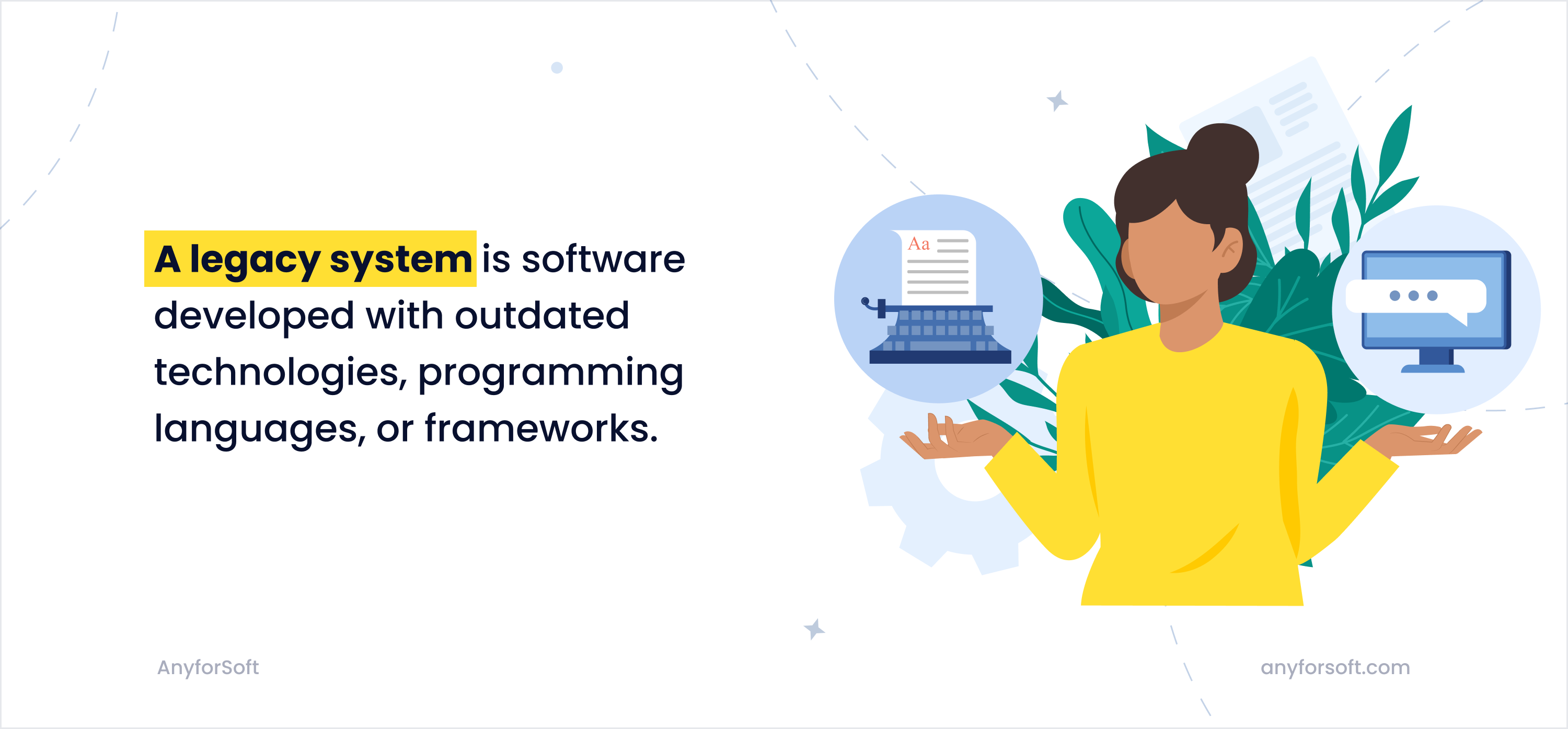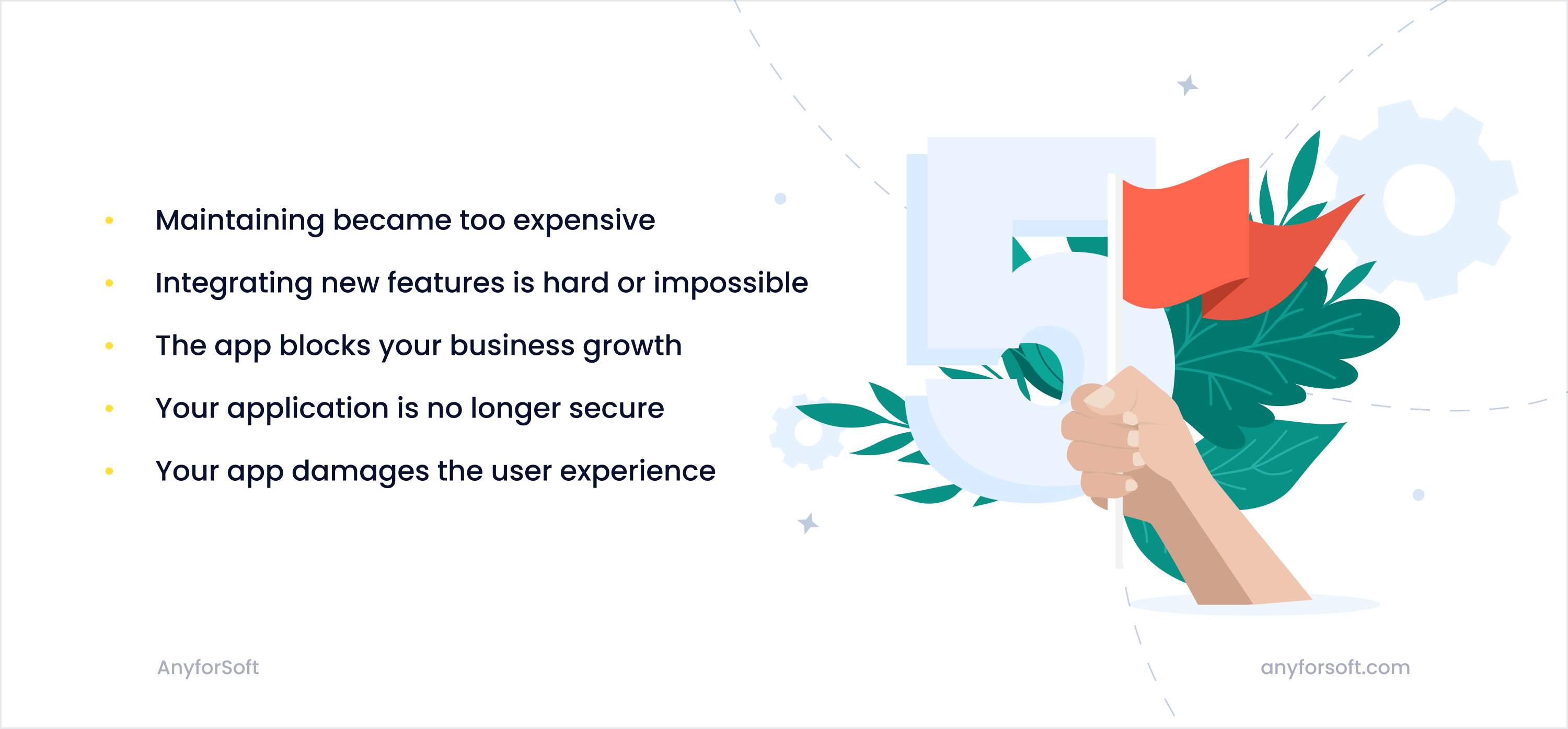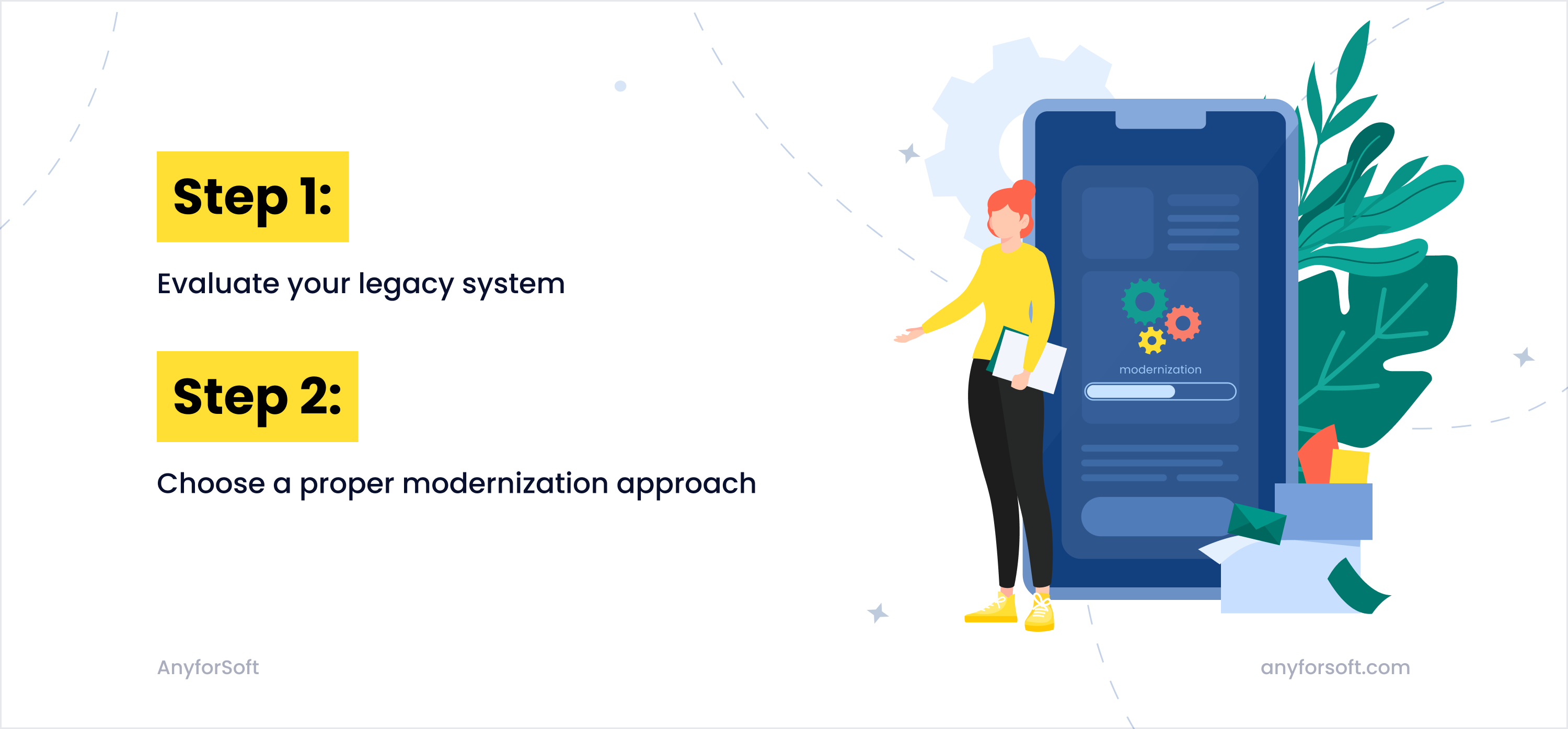Every system eventually turns into a legacy system. As technologies and programming languages evolve, applications created long ago become outdated. They get expensive to maintain, accumulate lots of bugs, grow vulnerable to security threats, and become hard to integrate with newer technologies.
That’s why every business should consider legacy application modernization at some point.
Legacy application modernization is the process of updating and enhancing existing software applications that were developed with outdated technologies, languages, and frameworks. Its goal is to transform outdated software into modern, efficient, and flexible solutions that meet the current needs of a business.
As a software product developer with over 12 years of experience, AnyforSoft wants to elaborate more on this topic and explain how to modernize legacy applications. This article will help you future-proof your app and ensure its successful digital transformation.
You will learn:
- What legacy systems are.
- How systems become legacy.
- How to tell whether your app requires modernization.
- Why you should invest in legacy app modernization.
- What legacy application modernization approaches are there and which one you should choose.
Let’s dive in!
What are legacy apps and how systems become outdated

Simply put, a legacy system (or application) is software developed with outdated technologies, programming languages, or frameworks. These applications are often older and have been in use for a significant period. They may be built on platforms that are no longer widely supported or lack compatibility with modern technologies.
For example, Windows 7 is considered to be legacy software, as it is no longer supported by Microsoft.
In general, any system that has reached its end of life, no longer receives updates and security patches, can’t be scaled, or relies on outdated architecture is a legacy system.
How systems become legacy
There are many scenarios of how a modern business application may turn into a legacy app.
The first example is when the developers that built your product are no longer with the company and there is a lack of proper documentation. As a result, when new developers come, they have a hard time understanding how your application’s code works. That leads to issues with maintaining, upgrading, and scaling the application.
Another example is when the software or framework your system relies on reaches its end of life. Say, you built a web app on Drupal 7. Then comes Drupal 7’s end of life, so the CMS no longer receives updates and security patches. That makes your application vulnerable to security threats, so you better go for legacy application modernization.
And of course, we shouldn’t forget about technological advancement, As technology evolves, older systems become outdated and less efficient compared to newer alternatives. New programming languages, frameworks, and development methodologies emerge, offering improved capabilities and performance. If a system is not regularly updated to leverage these advancements and modernize business operations, it gradually becomes outdated and is considered a legacy system.
How to tell when you need legacy application modernization: 5 red flags

Now that you know what legacy systems are and how applications become outdated, the next question is, how to tell whether you need legacy system modernization?
Well, here are five red flags:
- Maintaining your app requires too many resources. If you’ve noticed that your app takes too much time, money, and effort to maintain, that’s a clear sign that you need to modernize legacy systems.
- Integrating new features into your app is hard or impossible. The best thing about modern technologies is that they integrate with each other seamlessly. Most third-party tools and services have built-in support for all popular programming languages and frameworks, making the integration process fast and easy. In the case of legacy applications, however, integrations require lots of custom code. So if new features are too hard or impossible to integrate, modernize your legacy software as soon as possible.
- The app blocks your business growth. If your software no longer satisfies your business needs and requirements, if it hinders your business operations and stops you from growing, then it’s time for legacy application transformation.
- Your application is no longer secure. Since legacy systems are old and created with outdated technologies, programming languages, and frameworks, they’re susceptible to cyberattacks, malware, and other security threats. If you’ve noticed that your application no longer meets security standards, you better invest in legacy modernization before it is compromised.
- Your app damages the user experience. A business that wants to provide the best user experience should be quick to respond to user needs and demands. That means that whenever your customers require new features or technologies, you should be able to introduce them as quickly as possible. Obviously, legacy systems lack organizational agility and can’t swiftly adapt to changes, which damages user experience and customer satisfaction.
Why you should invest in legacy application modernization
Many businesses are reluctant to modernize their legacy systems. That’s perfectly understandable. Why touch something if it works, right? Besides, the modernization of legacy applications is costly and time-consuming: many companies simply don’t have the budget needed to upgrade their outdated software.
However, even though legacy application modernization requires significant upfront investments, it provides many benefits in the long run. By opting for it, you avoid multiple risks associated with keeping legacy applications and systems. Below we list the most common ones.
High maintenance costs
As just noted, many businesses don’t modernize legacy software as it requires large investments. However, keeping a legacy system proves to be more expensive in the long run. If you rely on an outdated system or technology, that means you have to support and maintain it by yourself (since the vendor no longer releases updates), which incurs ongoing costs.
Poor performance
Software that relies on outdated technologies can’t keep up with high performance standards. Your avoidance of legacy modernization results in slower performance, higher resource consumption as well as frequent software crashes. Besides, by maintaining an old technology stack, you are not taking advantage of newer technologies, lagging behind your competition.
Data silos
A data silo is when data is stored, managed, and maintained in isolated systems or applications. Many legacy systems cannot integrate with new software, which means that data stored on an older system within a business cannot be shared with other departments that rely on newer systems. That hinders efficient data utilization and collaboration between departments.
Compliance issues
Legacy applications often fail to meet the standards of data compliance regulations. This leads to fines and penalties. Moreover, it makes the system open to multiple security threats.
Lack of security
Since legacy systems typically don’t receive support from their vendors, they rely on outdated security patches. That results in data breaches, which, by the way, cost organizations an average of $4.35 million according to IBM’s “Cost of a Data Breach” report. To avoid these and other risks, product owners should opt for modernizing legacy applications. In the following paragraphs, we describe how it is done.
How to modernize legacy applications: 2 essential steps

Legacy application modernization requires two essential steps.
Step 1: Evaluate your legacy system
The first step in your digital transformation is to evaluate your legacy system from both a business perspective and a development perspective.
There are three factors to consider from a business perspective: business fit, value, and agility. If your application fails to meet the new requirements of your business, it should be modernized and upgraded to provide greater value. The same goes for solutions that lack agility and are unable to keep pace with the business demands.
From a development perspective, you should take into account cost, complexity, and risks. If your application costs too much, the technology is complex, or its scalability is impossible, you should modernize it.
When it comes to legacy application modernization, there are 7 approaches to choose from.
Step 2: Choose a proper modernization approach
Once you evaluated your legacy systems, it’s time to choose the modernization approach that best fits your business:
- Encapsulate. Encapsulation is when you wrap your existing application and code as an API within a new application. Thus, your app won’t change, but it will be available as an API that other applications can communicate with.
- Rehost. Rehosting implies redeploying the application component to other infrastructure (physical, virtual, or cloud) without making changes to its code, features, or functions.
- Replatform. Replatforming is when you make minimal changes to the legacy application's codebase while migrating it to a different platform or technology stack. It enables you to take advantage of the benefits offered by the new platform while requiring minor adjustments to ensure compatibility.
- Refactor. Refactoring is when you are restructuring and optimizing the existing code of your legacy application to remove technical debt and improve nonfunctional attributes.
- Re-architect. This legacy application modernization strategy involves changing the code to shift it to a new application architecture with better capabilities.
- Rebuild. Rebuilding is when you completely redevelop the legacy application from scratch without making changes to its scope or specification.
- Replace. If your legacy app doesn’t meet your business needs and requirements anymore, another option you have is to completely replace it with a custom or off-the-shelf solution (learn more about the differences between custom vs off-the-shelf software).
Conclusion
Legacy application modernization is costly and time-consuming. Yet, maintaining and supporting a legacy system is even more expensive and complicated. If you fail to constantly update your code and embrace newer technologies, you will end up with an app that requires high maintenance costs, performs poorly, has lots of security and compliance issues, and doesn’t satisfy your business needs and requirements.
Don’t let it become your reality—modernize your legacy application whenever such a need arises and ensure your business’s growth and prosperity.
In case you need help with legacy modernization, you can always count on professionals from AnyforSoft. Over 12 years of development experience allows us to work on modernization projects of any complexity. Just contact us at any convenient time, and we will help you with your legacy systems!
FAQs
Businesses use legacy applications and systems for various reasons:
- Because they still work. And if they work, why touch them? When a system still satisfies the needs and requirements of a business, modernizing it is not necessary.
- Because modernization is expensive. It requires a large upfront investment that many companies lack.
- Because modernization is time-consuming and challenging. Besides, it may require the system to go down for a significant amount of time, resulting in revenue loss.
Businesses use legacy applications and systems for various reasons: Because they still work. And if they work, why touch them? When a system still satisfies the needs and requirements of a business, modernizing it is not necessary. Because modernization is expensive. It requires a large upfront investment that many companies lack. Because modernization is time-consuming and challenging. Besides, it may require the system to go down for a significant amount of time, resulting in revenue loss.
There are six factors you should take into account to choose the right strategy for modernizing your legacy application:
- Risks. Evaluate the associated business risks of modernizing your outdated software.
- Workload/migration scope. Audit your current legacy systems and identify which features require modernization.
- Architecture. Evaluate your app’s infrastructure as well as performance and assess where newer technologies may come in handy.
- Operations. Assess your business operations and identify new skill sets that will be needed for your team to use the modernized system. You should also assess the complexity of the codebase, level of technical debt, and compatibility with new technologies
- Security. Protect your legacy system before, during, and after the modernization process to avoid loss of critical data. Ensure that the new environment complies with governmental and industry regulations.
- Financial investments. Calculate the expenses required to modernize your legacy application. The availability of your budget will directly your legacy software modernization strategy.
All that will help you find the most suitable legacy system modernization strategy.
There are six factors you should take into account to choose the right strategy for modernizing your legacy application: Risks. Evaluate the associated business risks of modernizing your outdated software. Workload/migration scope. Audit your current legacy systems and identify which features require modernization. Architecture. Evaluate your app’s infrastructure as well as performance and assess where newer technologies may come in handy. Operations. Assess your business operations and identify new skill sets that will be needed for your team to use the modernized system. You should also assess the complexity of the codebase, level of technical debt, and compatibility with new technologies Security. Protect your legacy system before, during, and after the modernization process to avoid loss of critical data. Ensure that the new environment complies with governmental and industry regulations. Financial investments. Calculate the expenses required to modernize your legacy application. The availability of your budget will directly your legacy software modernization strategy. All that will help you find the most suitable /*-->*/ legacy system modernization strategy.
